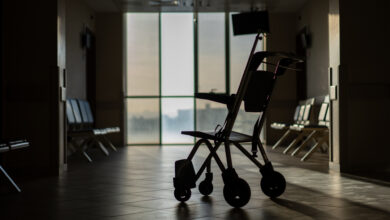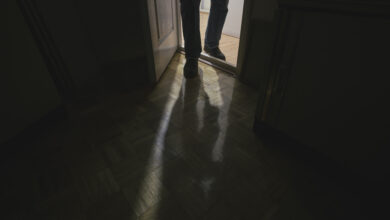From the other side of the bed
When a family member is hospitalised with a critical illness, not knowing what is happening can increase ones fear and anxiety. But sometimes knowing can make the experience that much worse. Annie May reports.
It was November of 2001 when Susan Salmond walked into every mother’s worst nightmare.
Arriving at her then 22-year-old daughter’s apartment, she found her unresponsive and having a seizure. Having epilepsy since birth, she was in status epilepticus.
It was the beginning of an emotional draining eight months, with Salmond having intimate contact with the health care system. This contact was not unusual in itself, but this time it was from the other side of the bed. Her experience with the health care system and her daughter’s critical illness was somewhat different than the typical family member because she is a nurse.
“My role as a nurse put me in a different position. I wanted and demanded a different type of care. Some nurses supported me in this process, others excluded me,” she said.
This experience stayed with her long after her daughter was released from hospital, leading the dean of University of Medicine and Dentistry of New Jersey’s School to conduct a study examining the experiences nurse family members of an adult relative hospitalised for a critical illness.
“I wanted to know whether my experience was typical of other family members who are nurses,” Salmond said. As part of her study, she interviewed 22 nurse family members were interviewed, all of whom worked at different US health care facilities.
When critical illness of a loved one occurred, all participants indicated that their nurse role identity was intertwined with their family member role identity and could not be separated, Salmond said when reporting on her findings in a recent issue of Intensive and Critical Care Nursing.
In fact, most identified that they were a nurse before they were a family member.
One participant – a daughter – stated: “The nurse in me came first and had to be sure that the care dad got was what it should be. I was his daughter throughout but the nurse side of me had to be satisfied for the daughter in me to give up control.”
It is the unique nursing knowledge that the nurse family member brings to the situation that sets them apart from the non-nurse family member, even though some of the challenges or tasks are common to all family members.
Nurse family members found the critical illness experience to cause panic, fear, and acute anxiety. Similar to other family members, these emotions stemmed from the uncertain outcomes but, said Salmond, these emotions were heightened because of the added dimension of the nurses’ knowledge base.
“These nurses understood what could go wrong from a disease perspective and perhaps even more importantly, they knew what could go wrong because of hospital-induced error,” Salmond said.
When interviewed, one sister said: “At times it was like no matter what they said to me, I could not feel comfortable and confident that everything was going to work out. I kept thinking of the ‘what ifs’ and kept wishing I did not know anything so I could just go in there and sit by the bedside and just be supportive. Knowing made it much harder.”
While all of the nurse family members identified the stress of ‘knowing’, the experience was different when the relative was hospitalised in the nurse family members own institution. These participants indicated their relatives received extra attention in terms of monitoring and early action.
“They were included as part of the team and information was openly shared, their opinion solicited, and a plan of care agreed upon,” said Salmond.
This was the experience of one wife: “There is an old saying, ‘where ignorance is bliss, tis folly to be wise.’ Sometimes I wished for no knowledge so I could be more hopeful, less anxious. But then I would realise, without my knowledge the nurses and doctors wouldn’t have responded as quickly to the complications that were developing and I was pointing out and discussing with them…getting a plan of action. They knew me and respected me and did not exclude me.”
Nurse family members also admitted to wearing a ‘mask’ so that they appeared in control.
The nurse side of the nurse family member wanted to take charge. The family also expected the nurse family member to interact with the health care team, to keep the family informed of what was happening, to interpret meaning for them, to assure that ‘proper’ care was administered. And to sustain their hope.
“Achieving these objectives required them to internalise much of their own fear and to mask their emotions so they could be in-control and able to take charge. With someone in-charge, other family members could grieve, display their emotions, and seek support from each other,” Salmond said.
“Although an integral part of the family, the nurse family member was somewhat on the outside as she assumed the in-control position.”
However, the nurses with family members in their own workplace acknowledged that the nursing staff was sensitive to their situation and saw through the façade. The experience was different for most in unfamiliar environments where they described little emotional support and attributed this to their appearance of “being able to handle it” and the overall technical focus of the nursing staff.
In the role of the in-control person, the nurse family member’s first objective, found Salmond, was to be “let-in” to be with the patient. Not being let-in, which often was the case for members in unfamiliar environments, was the cause of much stress and left them feeling out of control and helpless.
Again, for those who were in their own workplace, more allowances were made and they were not kept out unless their loved one was in the operating room. “They were treated as a special member of the team.”
Nurse family members interviewed spoke of intentionally building relationships in order to get detailed information. Recognising that some staff nurses found it intimidating interacting with the nurse family member, they purposefully presented themselves as helpful and non-critical, watching the nurses’ reaction and altering their own behaviour to make the staff more comfortable.
A nurse family member whose father was being cared for in her place of employment acknowledged the stress that caring for her dad placed on some of the staff nurses because of the possibility that “something were to happen to him and that I would hold them responsible.”
Meaningful information was the key to lowering nurse family member stress and building confidence and trust in the staff. For nurse family members within their own hospitals, this was not a problem, said Salmond. But for nurse family members outside of their own place of employment many spoke of initially receiving general information such as “he’s doing better,” or “her breathing is better”.
“This lack of detail was unacceptable and they worked on building relationships in order to receive the detailed information that their “nurse self” needed to understand what was happening, to provide feedback to the rest of the family, and to feel in control,” said Salmond.
Advocating for their loved one was seen as an integral part of their role. This advocacy occurred with or without collaboration, however, patient and family needs were best served when collaboration existed. Advocacy included making sure they were present so that they could inform on-coming shifts about the patient, knowing what questions to ask, asking for specific interventions and speaking out against care that did not meet standards.
Nurse family members told Salmond that it was their active advocacy role that often facilitated improvements of care and promptness of care. It also was the active advocacy that made some of the nursing staff most uncomfortable.
The nurse family members in collaborative situations described the most comfort and satisfaction with care, while not surprisingly the most distressing stories were those where the nurse family members felt there was no collaboration on the part of the staff. These nurse family members described consistently “not being let in,” unable to build relationships with staff and staff unwilling to listen, to share data, or to advocate.
“Trust and confidence in the nursing staff was required before the nurse family member could lessen her hold on the “nurse self” and allow one’s family self to emerge. In these cases the nurse family members felt confident that their loved ones were receiving quality care,” Salmond said.
For some this point was not reached and they remained in a state of heightened emotional turmoil and continued their roles of surveillance, information seeking and advocacy.
Salmond said critical care nurses could use her findings to plan for a family-centred model of caring for the nurse family member.
“By openly sharing information and clarifying its meaning the nurse family member is in a position to share concerns over the patient and together the nurse family member and critical care nurse can advocate to assure that the patient’s needs are met in a safe, efficacious manner.”
Email: [email protected]





